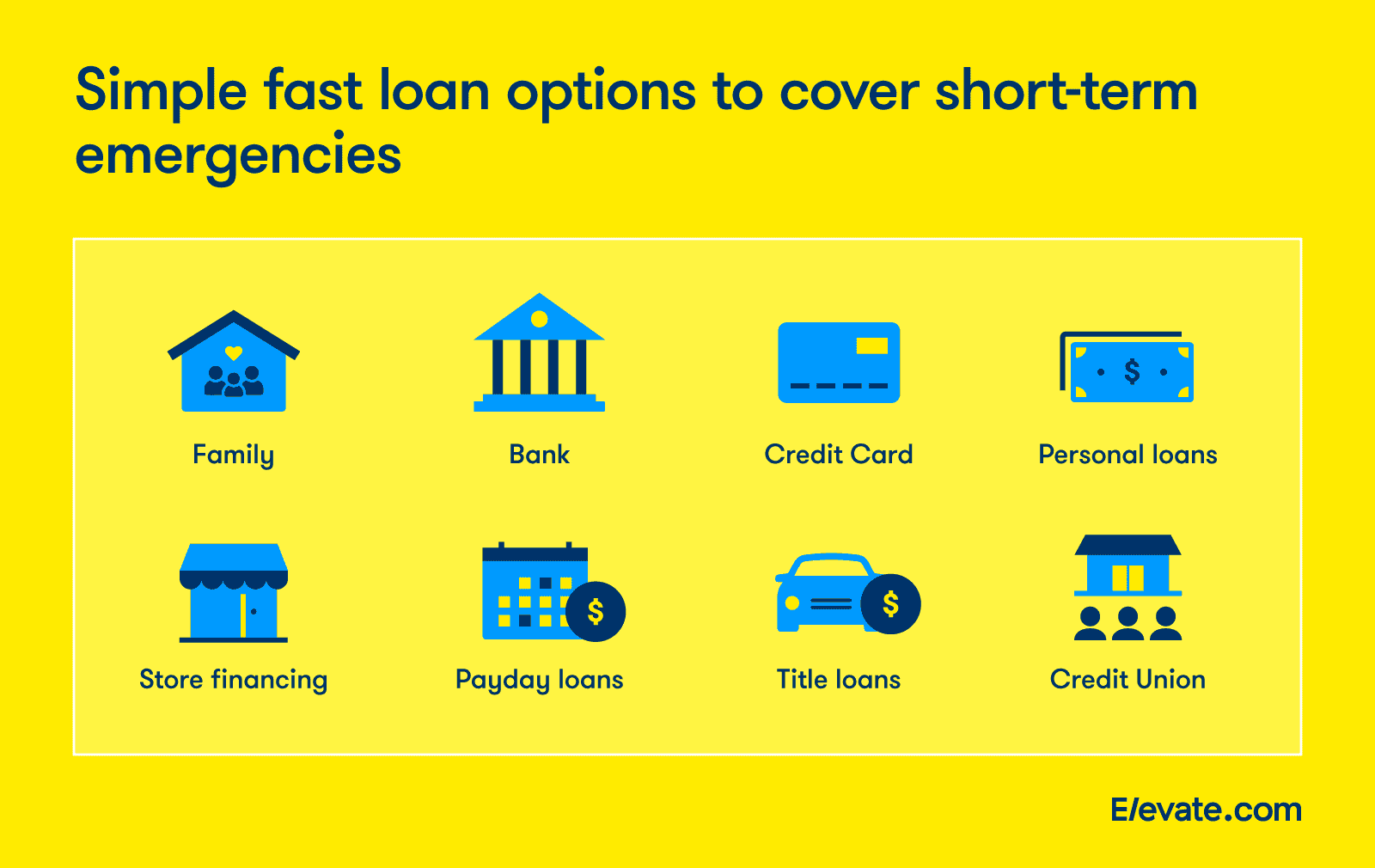Responsible Borrowing
How Can I Cover a Cash Shortfall?
Part of the Series: Building and Using Credit
Apr 8, 2021 15 min read

Summary
- When you need to borrow money, it’s sometimes hard to know what your best options are.
- There are so many services offering to give you money but it can be tough to find the right one for you.
- The following is a quick guide on the different options you may consider when shopping around.
Bank Account Overdraft
An overdraft is a fee that a bank or a credit union charges you when your account dips to a a negative balance. Overdraft fees vary bank but are usually over $30 (according to the Consumer Financial Protection Bureau). Customers pay that fee on each transaction as soon as their account runs into a negative balance.
At a Glance
- Range: $1 to $200
- Fee: $30 - $40 per transaction
- Interest Rate: None
- Other Costs: Additional charges if not repaid within one week.
- Uses: Good for covering a single expense that comes before payday, like groceries, or a bill with a late fee higher than the overdraft fee.
- Timing: Immediate, if you have activated overdraft protection with your bank.
Considerations
This is generally the most expensive way to cover a small cash shortfall, but it’s also the easiest. Most banks require you to “opt in” to allow overdrafting, otherwise the transaction will be declined. This can serve as a form of protection if your balance occasionally dips below $0. Most importantly, it is intended for those who can repay the fee and restore a positive balance within a few days.
Banks can charge an overdraft for every pending purchase but depending on your bank’s policies, you may be limited to the number of transactions or amount you can overdraft. If you have to pay a bill with a late fee that’s less than the amount of your overdraft fee then we don’t recommend using this method.
Payday Loan
Payday loans allow you to borrow against future income — like a paycheck or Social Security income — and receive funds quickly, sometimes without a credit check. But keep in mind, payday loans typically come with higher fees or interest than other loans. However, because of their small amounts and short terms, they are actually more comparable to overdraft fees.
At a Glance
- Range: $100 to $1,000, depending on state regulations.
- Fee: 0-30% of the loan amount
- Interest: 0 - 400%
- Other costs: Repeat Fees if not repaid in full on the due date.
- Uses: Payday loans may be right for those who need quick funds, like for an unexpected car repair or another one-time expense that is more than an overdraft can provide. They sometimes don’t require a credit check but tend to be more expensive. The costs can add up quickly if the loan is not paid off on the due date.
- Timing: Store front lenders can often provide cash immediately while online lenders may take a few hours to a few days to provide the funds.
Considerations
Payday loans can help you bridge a gap in your finances until your next paycheck arrives. Qualifying is usually a smooth process. Most payday loan providers verify income but are happy to work with customers who have a damaged or limited credit history.
Keep in mind, though, that payday loans are designed to be repaid quickly, often on your next payday. While you can extend, or “roll over” the loan, you’ll pay another fee each time you do so.
Because of their high costs, payday loans are not ideal if you need to borrow money more than once or twice a year. The cost of a payday loan in most states ranges from $10 to $30 for every $100 borrowed, according to the Consumer Financial Protection Bureau. These charges are made each time the loan is taken or renewed, typically every two weeks.
You should consider another option if you aren’t certain you can repay the loan by your next payday. You may have the option to extend or “rollover” your loan if you can’t pay it back on your next payday, but this means that you will have to pay the fee from your existing loan and another fee on your new loan due date.

Credit Card Cash Advance
By using the available balance on your credit card as collateral, you can get cash as you would from an ATM, but this will reduce your available credit.
At a Glance
- Range: $10-$1000. The amount you can borrow will vary depending on your credit line.
- Fee: 3-8% of the advance
- Interest Rate: 20-36%
- Other Fees: ATM fees and minimum charges
- Uses: A cash advance may be the answer for those who need quick access to cash to cover an emergency, such as a late rent payment. It should be used when cash is required and credit cards are not accepted.
- Timing: You can generally get a cash advance quickly by visiting a bank lobby or going to an ATM that displays a Visa or MasterCard logo. You’ll need a PIN to withdraw from an ATM, and you’ll have to request it in advance if you don’t already have one.
Considerations
While a cash advance is an easy way to get funds quickly, it does come with fees. Depending on your credit card issuer, you may pay a flat fee or a percentage of your total cash advance, up to a certain limit. You may also have to pay an ATM fee to withdraw your cash.
Taking a cash advance might also cancel out a low introductory interest rate that you may have received when signing up for the card. If you have an introductory rate of 0% APR for 12 months, but take a cash advance after six months, the interest rate may immediately increase to the standard rate for the card, so you should check your credit card agreement.
It’s important to read the fine print and understand how long it could take you to pay off a cash advance. For example, if you make the minimum payments, it could take a year or more to pay off even a small advance once the interest begins accumulating.
Personal Loan
Personal loans are flexible - You can take out a personal loan for almost any need, from covering an unexpected expense to consolidating debt. Most personal loans have set repayment terms with bi-weekly or monthly payments. They are intended to be paid back over a few months to several years.
At a Glance
- Range: $500 to $5,000
- Fee: 0-10% of loan amount
- Interest Rate: 15-300%
- Other Costs: Some lenders may add loan insurance and/or a prepayment penalty.
- Uses: Personal loans are a good option if you have a bigger expense you need to cover now and repay in installments. Many people take out personal loans to cover medical expenses, do necessary home repairs, or consolidate high-interest debt.
- Timing: Approval for a personal loan can occur within a few minutes to a few days of an initial application and credit check.
Considerations
Personal loans are good if you can stick to a regular payment schedule and have fair credit or better. The interest rates are based on the lender’s judgment of the borrower’s risk. Be sure to read the fine print, as some loans charge fees for early payoff.
Making on-time payments on your personal loan can help boost your credit score if your lender reports to credit bureaus. Keep in mind, there are personal loans that go up to $100,000, but you should only borrow what you need to cover your expense and then repay it according to the schedule laid out.
The total cost of personal loans can sometimes be hard to judge and compare. Personal loans can come with a wide variety of terms, so it might take extra effort to compare them. Some have high origination fees and a low interest rate while others have no origination fee and a higher interest rate. Some have late fees, application fees, and loan insurance that can add up when it comes to repaying your loan. You should consider the total cost of borrowing as well as whether the loan terms work for your lifestyle before borrowing.
Line of Credit
A line of credit is a flexible loan with an approved limit that you can borrow from again and again as long you pay down, or completely pay off, the balance.
At a Glance
- Range: $1000 - $10,000
- Fee: 1-15% of the amount borrowed
- Interest: 0 - 36%
- Other Costs: Usage fees may be charged in lieu of or in addition to interest.
- Uses: A credit line is designed for people interested in tapping funds over time, like for a major home repair. They are also good if you need to borrow funds on occasion but may not know the exact amount you’ll need to borrow at any given time.
- Timing: Timing for a line of credit largely depends on your existing relationship with a lender but usually can be completed within a few days.
Considerations
Lines of credit can be used for almost anything. If you can make the monthly payments, a line of credit can be ideal for covering unforeseen expenses. Unlike other forms of borrowing — like a personal loan that arrives in one lump sum — you can borrow from a line of credit as needed. This gives you more flexibility in the future and can keep you from taking on more debt than needed.
With a personal line of credit, you can even improve your credit score. If you’re given a $5,000 credit line but take only $500, that is reported to the credit bureaus as part of your credit utilization rate. And just like on a credit card, the lower your credit utilization, the higher your score. You’ll even get the credit benefits of on-time payments. However, unlike a credit card, interest on a line of credit usually starts accruing on the day you borrow.
Title Loan
A title loan allows you to borrow funds using your auto title as collateral (assuming you own your vehicle outright). While you can get one quickly and easily, they come with the risk of losing your car if not paid back promptly.
At a Glance
- Range: $100 - $5,000
- Fee: 10-25% of loan amount
- Interest: 0-36%
- Other Costs: Application and title fees are common.
- Uses: Those who own a car outright and need to borrow money for a temporary hardship
- Timing: These loans can be completed quickly, often within hours, depending on where you get them.
Considerations
Because title loans require collateral (your car), getting approved is often quick and easy, even if you have a limited credit history. And although you’ve put up your car as collateral, you’ll still have to pay a fee and interest on the loan. The total amount you can borrow will depend on the age and condition of your car. Generally, the loans range from 25 to 50% of the car’s value.
The biggest consideration, though, is that if the loan is not repaid, the lender may be able to take possession of your vehicle. In most cases, title loans are meant to be repaid within 30 days.
Pawn
You can get cash in exchange for jewelry, tools, firearms, or other goods through a pawn shop, or pawn lender. The item is held as collateral for a short-term loan, typically for 30 days.
Who Is It Best For?
- Range: $50-$500
- Fees: 5-25% of loan amount
- Interest: 0-36%
- Other Costs: Repeat fees if the loan is not repaid by the original due date.
- Uses: Pawn may be an option for people who have an object of value (ideally not sentimental) they can offer as temporary collateral for a loan. While most pawn shop loans are small, the funds can be used to cover unexpected smaller expenses or late bills.
- Timing: Pawn loans can be doled out within minutes of visiting a shop with your valuables.
Considerations
Typically, you will receive only 25 to 50% of the market value of your item for a loan. For example, if you give a pawn shop jewelry valued at $1,000 as collateral, you may receive only a $250-$500 loan. You’ll also need to pay interest or a fee to reclaim your item. The upside is that these loans can be handled quickly, often in one trip to the pawn shop. If you are unable to payback the loan, the pawn broker will sell what you used as collateral to cover the debt.
Borrowing from Friends or Family
Many people choose to take out an informal loan through friends or family. While these loans are often easily obtained and the least expensive form of credit, they could come with strings attached and potential emotional complications.
At a Glance
- Range: ?
- Fees: $0
- Interest: 0%
- Other costs: Non-monetary implications
- Examples: Those who have people in their inner circle who can lend you the money. Those who have a solid repayment plan may also be able to sidestep some potential emotional and relationship pitfalls.
- Timing: Immediate, after you and your loved one have decided the terms
Considerations
Getting a loan with no origination fee and no interest sounds fantastic, but, money can change the nature of a relationship. The potential consequences of borrowing from a friend or family member are much harder to anticipate than those laid out by a bank or lender. So it’s very important to be honest and discuss your repayment expectations and terms with your loved one before you accept the money.
Some families have formed “lending circles” with several people paying into a fund that the participants take turns drawing from. This is a good way of building a savings or borrowing when things come up, but it relies on cooperation and good communication skills.
About the author
Nathan Foley questions everything — and thinks you should too. As Elevate’s resident mathematician, he pores over datasets to find the truth amid the fluff and translates insights into ideas for improving personal financial resilience.
SERIES
Building and Using Credit






